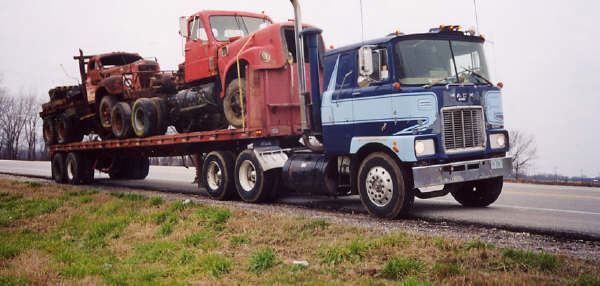Class Truck Predecessor Mack H series | Production Worldwide Transmission Mack (manual) | |
 | ||
Body style Truck (cab over engine) | ||
The Mack F series was the third generation of cabover trucks from Mack Trucks. Its production began in 1962 and ended in 1981. It was produced primarily as a set-forward axle truck but a setback axle version was shipped overseas (from the USA). The cab came in a 50 inch (1371.6 mm) day cab (no sleeper). Sleeper models included a 72 inch (1828.8 mm), 80 inch (2032 mm) and later a "bustle back" was added that lengthened the sleeper to 86 inches (2184.4 mm).
Contents
Model range
Macks Improvements on fuel economy and engine life
The Maxidyne high-torque-rise engine design, in combination with the Maxitorque five or six speed transmission offers less shifting, easier operation and excellent fuel efficiency. Maxi-Miser road speed governor, used in conjunction with a numerically-low rear-axle ratio, provides addition fuel economy. Maxi-Miser governs the engine to 1600RPM in cruising gear. By reducing the governed engine RPM to 1700, and using multi-speed transmission, engine revolutions per mile are reduced, and improved fuel economy is gained by maintaining the engine operating range between 1300 and 1700RPM which is the most efficient area of the fuel curve.
Engines
The F Model offered 4 different diesel engines, a Mack's Maxidyne and Thermodyne at 260-375 hp, Cummins - 250-350 hp, Detroit Diesel - 270-430 hp and Caterpillar - 325 hp. A wide range of diesels was also offered. From the B61 up the ENDT 673 turbocharged I6 and END 864 V8 were offered. From the B73 up Cummins 855 cu in (14.0 L) I6s up to the NTC335 were available.
The table shows the Mack diesel engines available in the series.
Chassis
The Mack F series truck uses taper-leaf front springs, which helps to provide a smoother ride. Taper-lead springs practically eliminate the inter-leaf friction, which is common with multi-leaf spring systems. The taper concept uses springs of equal length and different contour, to assure the springs do not slide against one another while in normal operation. This arrangement, accompanied by forged aluminum rear brackets and shackles equate to a comfortable ride.
Dual reduction are standard on Mack bogies, with straight-trough dual-reduction drive carriers as standard, requiring no transfer gearing and provide excellent driveline angles. This design, exclusive to Mack, permits shorter wheelbases, extended “U” joint life, lower bearing side loads and reduced vibration. The custom engineered frames are the envy of the industry.
Chassis Equipment
Extensive Testing
Exclusive Mack Finish
A Mack truck is unique to all other trucks due to its offering of additions, which transform the working truck into a rolling luxury vehicle. Mack allows the addition of aluminum step and walk grating, chrome air intake and exhaust stack, stainless exhaust shield, stainless steel grab handle, chrome door handles, chrome air horns and batter box, polished aluminum fuel tanks and polished aluminum bumpers, and polished West Coast Mirrors.
